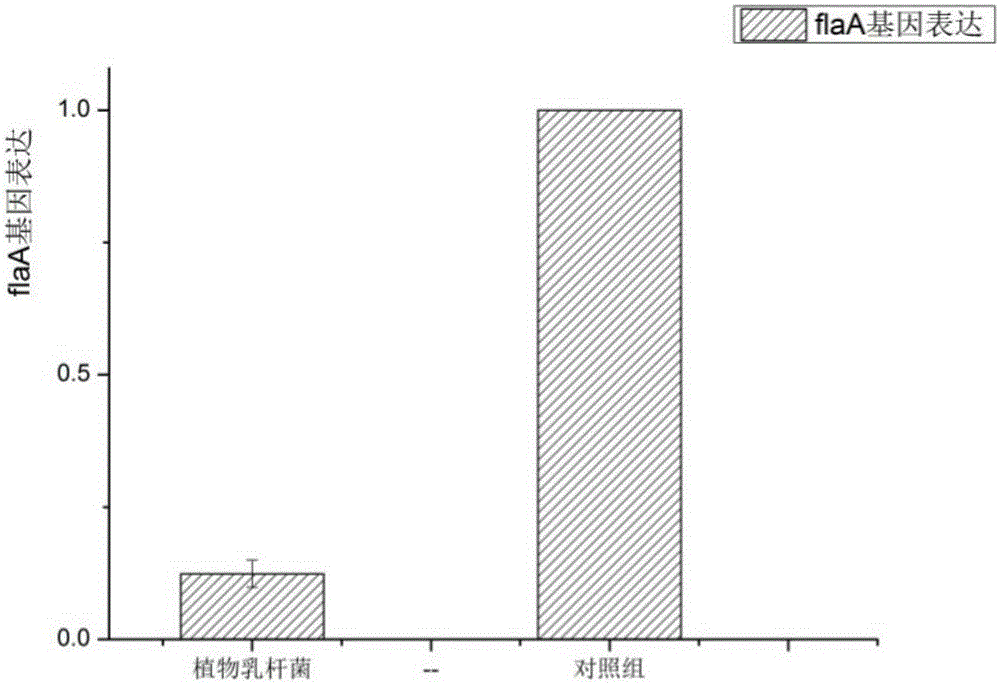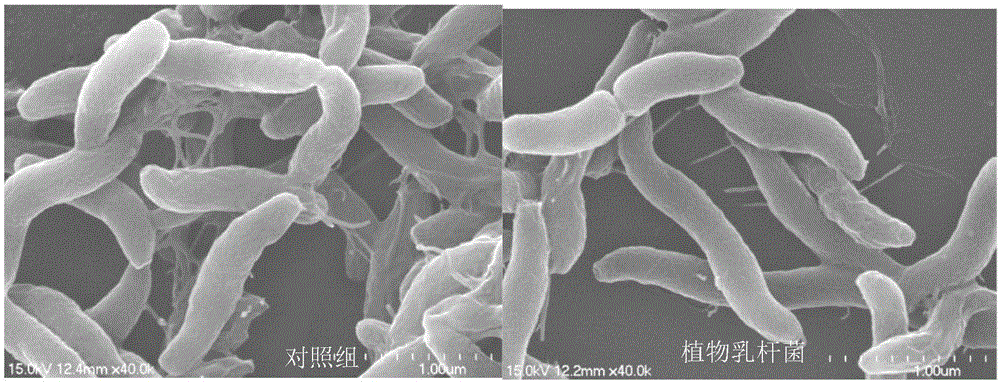Lactobacillus plantarum capable of antagonizing campylobacter jejuni and inhibiting expression of flaA gene of campylobacter jejuni
A technology of Campylobacter jejuni and Lactobacillus plantarum, applied in the field of microorganisms, can solve the problems of not involving Campylobacter jejuni, not many, reducing Campylobacter jejuni antigens, etc., and achieve good adhesion characteristics, growth inhibition, and wide application prospects
- Summary
- Abstract
- Description
- Claims
- Application Information
AI Technical Summary
Problems solved by technology
Method used
Image
Examples
Embodiment 1
[0035] Embodiment 1 screens lactic acid bacteria from Sichuan pickles
[0036] Samples were taken from Sichuan pickles and preserved in 30% glycerol. After homogenization, draw 1ml of kimchi suspension and add it to a test tube containing 9ml of sterilized physiological saline, oscillate evenly, and after gradient dilution, use the coating plate method to spread these diluted bacterial solutions on the surface added with the acid-base indicator olfactory cresyl violet On the MRS medium (Qingdao Haibo Biotechnology Co., Ltd. product) plate, carry out ordinary culture and anaerobic culture at a temperature of 37 ° C for 48 hours, observe the growth of the colony, and pick the bacteria that can make the olfactory cresyl purple in the medium turn yellow. The typical single colony, and carry out Gram staining on the single colony, pick the Gram-positive bacteria as the primary target strain, and then transfer to the MRS plate to separate and purify by streaking, until the pure lact...
Embodiment 2
[0037] Embodiment 2 uses the Oxford cup method to screen the lactic acid bacteria that can inhibit the growth of Campylobacter jejuni
[0038] Preparation of lactic acid bacteria fermentation supernatant: Inoculate the separated and purified lactic acid bacteria into MRS liquid medium at 2% by volume based on the volume of MRS liquid medium, culture at 37°C for 18 hours, and continuously culture for three generations in the same way, and then inoculate the lactic acid bacteria The bacterial suspension was centrifuged at 8000r / min and 4°C for 8min, the supernatant was absorbed, and sterilized by filtration with a 0.22μm water filter membrane to obtain the lactic acid bacteria fermentation supernatant.
[0039] Campylobacter jejuni (Campylobacter jejuni) NCTCl11168 strain (purchased from the American Type Culture Collection ATCC) on two media (i.e. Brooke's agar (product of Qingdao Haibo Biotechnology Co., Ltd.) and brain heart infusion broth medium ( Oxoid medium)) at a tempera...
Embodiment 3
[0044] Example 3 Tolerance experiment of Lactobacillus plantarum CGMCCNo.11445 to artificial intestinal juice and artificial gastric juice
[0045] Artificial gastric juice: Dissolve 3 g of pepsin (1:10000, Sigma, USA) in 1 L of normal saline (0.5%, w / v), adjust the pH to 2.0, pass the solution through a 0.45 / 0.22 μm sterile double-layer Pore filter membrane, sterile storage for future use.
[0046] Artificial intestinal juice: Weigh 1g of trypsin (P-1500, Sigma, USA) and 0.3g of ox bile salt, dissolve in 1L of normal saline (0.5%, w / v), adjust the pH to 8.0, pass the solution through 0.45 / 0.22μm sterile double-layer microporous membrane, aseptically stored for future use.
[0047] PBS solution (phosphate buffered saline): Potassium dihydrogen phosphate 0.27g, potassium chloride 0.2g, disodium hydrogen phosphate dodecahydrate 2.85g, NaCl 8.5g, distilled water 1L, pH adjusted to 7.2, pass 0.45 / 0.22μm without Bacterial double-layer microporous membrane, sterilized at 121°C ...
PUM
 Login to View More
Login to View More Abstract
Description
Claims
Application Information
 Login to View More
Login to View More - R&D
- Intellectual Property
- Life Sciences
- Materials
- Tech Scout
- Unparalleled Data Quality
- Higher Quality Content
- 60% Fewer Hallucinations
Browse by: Latest US Patents, China's latest patents, Technical Efficacy Thesaurus, Application Domain, Technology Topic, Popular Technical Reports.
© 2025 PatSnap. All rights reserved.Legal|Privacy policy|Modern Slavery Act Transparency Statement|Sitemap|About US| Contact US: help@patsnap.com



